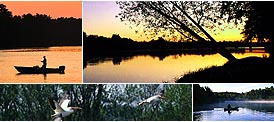
| Redfish | Sailfish | Sharks | Sheepshead | Snapper | Snook | Spanish Mackerel | Spotted Seatrout | Tarpon |

SHEEPSHEAD
Regulations
12" minimum size limit; no closed season; 15 per person per day limit
General Information
Because of its bold and distinctive black and white vertically striped body, sheepshead are often referred to as the convict fish.
Distribution
Sheepshead is one of the "staple" fish in Florida. It is a year round resident throughout the state. Land bound anglers find them around bridge and dock pilings and boaters will catch them around oyster bars and nearshore reefs and wrecks.
Tackle and Techniques
You won't need any special tackle for sheepshead. Reels rated for 6-12 pound test line with a corresponding rod is sufficient when fishing in the backwaters. Attach 12-18" of 20 pound test line as a leader and you're ready to go. When fishing offshore over wrecks and rocks, a medium to heavy duty spinning rig or a basic boat rod and reel with 20 pound test line and a 40 pound test leader will make it easy but still keep the fun in catching these strong fighting and tasty fish.
Bait
This species is a adept bait stealer. Equipped with front teeth that look remarkably like our front teeth, sheepshead can pick the bait off your hook without hooking themselves. Towards the back of their mouth they have molar-like teeth that crush and grind their food. Live fiddler crabs, live or dead shrimp, and sand fleas are some of the favorite baits.
Secrets to Success
* When fishing around bridge pilings, use a flat blade shovel to scrape some of the barnacles off the pilings. This natural chum often attracts fish to the area. Drift your bait into the chum slick and wait for the action to begin. Use only enough weight to keep your bait in the chum.
* Sheepshead have small mouth so select a small, sharp hook. The first signs of a bite are one or more light taps. Ignore these and wait until you detect a heavy feeling on the line. That's when you want to set the hook. Keeping the weight used down to a minimum gives you the most sensitivity to feel those first few light taps.












